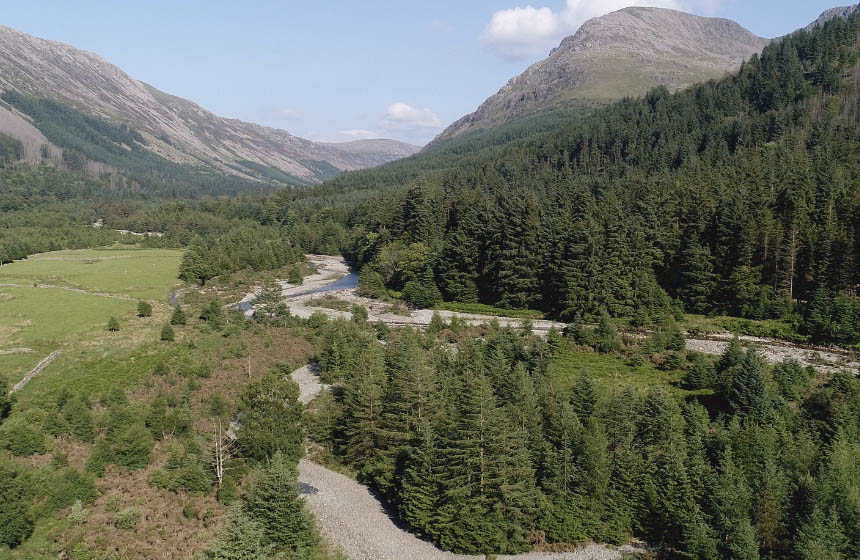River restoration and hillside stabilization near Swindale Beck
Restoring a historically straightened stream to its natural meandering path to slow the flow of water through the valley, reducing downstream flood risks and improving water quality, habitat creation, and biodiversity.
Nature-based Intervention:
In 2016, the Royal Society for the Protection of Birds (RSPB) partnered with the landowner, United Utilities, Natural England and the Environment Agency to ‘rewiggle’ the Swindale Beck. This project involved restoring 1,140 metres of heavily human-modified river, 1,000 hectares of bog and 15 hectares of species-rich hay meadow within the Swindale Beck catchment. This involved digging a new, sinuous channel, re-homing resident fish species, planting 40,000 trees within the catchment, and re-filling and re-seeding the old channel with wildflower seed from meadows designated as a Site of Special Scientific Interest and Special Area of Conservation either side of the river. The Swindale Beck restoration is part of a wider set of works within the Swindale Valley that use best-practice land management for flood alleviation.
Overview of context and outcomes:
Approximately 200 years ago, the community of Swindale undertook a project to straighten a section of the beck running along the valley bottom, with the aim of speeding water flow through the valley and increasing the amount of farmland. This had the consequence of increasing flood risk for people living downstream and scouring away natural gravel banks that are important for wildlife. After the restoration environmental benefits were realised relatively quickly, with salmon spawning on the banks within months and enhanced habitat diversity able to support increased species diversity.
Case effectiveness on
Climate change
Though there is no reported climate change mitigation impact from the restoration of the Swindale Beck, it is reported that the wider project will lead to improved soil carbon storage from changed grazing practices and peat bog restoration.
The project reports that it will contribute to reducing flooding risk in Cumbria triggered by natural disasters, such as 2015’s Storm Desmond, which caused significant local damage. It is expected to provide flood risk reduction benefits to 150 properties at risk of flooding at Eamont Bridge, a village downstream of the Swindale Beck catchment.
Ecosystem health
Ecological effect: PositiveIt is reported that a few months after work was completed, salmon were able to spawn on the banks, for the first time in centuries. The increased habitat diversity now supports a much wider range of invertebrates, which in turn provide vital food for fish and birds, like dippers. The restored natural gravel beds provide suitable spawning grounds for Atlantic salmon (Salmo salar), and otters (Lutra lutra) have been seen hunting along the river’s new course.
Socioeconomic outcomes
The project has reportedly contributed to improved raw water quality in the Haweswater Reservoir, which is fed by the Swindale Beck, by reducing soil erosion and run-off and improving the land’s ability to store water. This is anticipated to reduce the need for expensive water treatment to bring drinking water up to the required standard. The project is also expected to contribute eco-tourism benefits to the local economy
Governance
Local participation in Governance: Not_reportedIn 2012, the Royal Society for the Protection of Birds (RSPB) leased Swindale Farm and nearby Naddle Farm from United Utilities for a period of 45 years. Associated with the farms are grazing rights on three upland commons. Farming operations on Swindale Farm are managed by a farm contractor working for the RSPB. The Swindale Beck restoration project was jointly led by RSPB and United Utilities, who partnered because of a shared interest in improving catchment management for wildlife and water quality benefits. Natural England supported on measures to protect the adjacent meadows and the Environment Agency provided wider catchment modelling.
Finance
The total cost of the project was £212,500. Funding was provided by the Environment Agency (£70,000), Natural England (£52,000), United Utilities (£40,000), RSPB (£25,000), and Cumbria Waste Management Environment Trust (£25,000).
Monitoring and evaluation
To support monitoring activities, projects have been initiated with UK universities to understand the environmental impacts of the river restoration project. RSPB reports carrying out detailed wildlife monitoring through robust plant and upland bird survey methods. Water quality and water flow is monitored by United Utilities. It is reported that modelling to assess the feasibility and contribution that new flood attenuation structures could make to downstream flows after extreme rainfall events is also being undertaken.
Trade-offs and limitations
No information is available yet on trade-offs.

Intervention type
- Restoration
Ecosystem type
- Peatland
- Streams, rivers, riparian
Climate change impacts addressed
- Freshwater flooding
Instigators
- Local private sector
- National conservation/environment organisation
Societal challenges
- Biodiversity conservation
- Climate change adaptation
- Disaster risk reduction
- Water security
Outcomes
- Food security: No effect
- Water security: Positive
- Health: Not reported
- Local economics: Not reported
- Livelihoods/goods/basic needs: Not reported
- Energy security: Not reported
- Disaster risk reduction: Positive
- Rights/empowerment/equality: Not reported
- Recreation: Not reported
- Education: Not reported
- Conflict and security: No effect
- No. developmental outcomes reported: 4
Resources
Read resource 1Read resource 2
Read resource 3
Read resource 4
Literature info
- Grey literature




